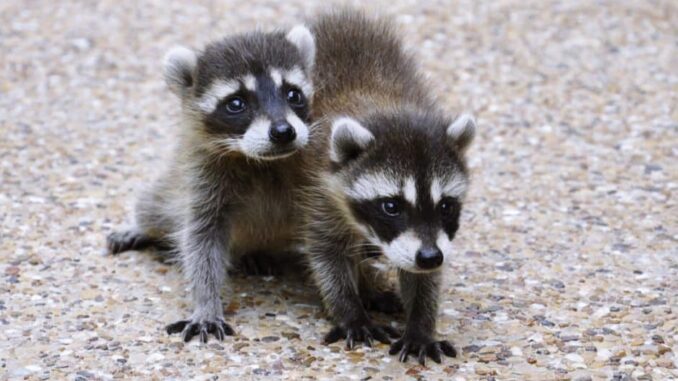
If you find baby raccoons on your property, determining their age can provide useful information. Raccoon kits rely on their mother’s care for the first several months of life. Knowing the babies’ approximate age gives you an idea of how much longer they may remain on your property before becoming independent. This can help homeowners know what to expect and plan accordingly.
Newborn raccoons are completely dependent on their mother. But at around 12 weeks of age, kits are weaned from their mother’s milk, eating solid foods, and showing independence. So if you discover a litter of baby raccoons, assessing their age helps determine when they may leave the nest on their own. Understanding their level of maturity also provides clues for how to safely manage the situation.
Table of Contents
Newborn
Raccoon babies are born hairless and with their eyes and ears sealed shut. They weigh just 100 grams or less at birth and measure only 4.5 to 6 inches long from nose to tail. Their legs are undeveloped, so newborns can barely crawl using a splay-legged motion.
Newborn kits vocalize with soft twitters, chattering, or whining sounds when hungry or distressed. They are unable to stand, walk, or support their own weight at this stage. Their heads appear oversized compared to their tiny bodies.
1 Week Old
At one week old, baby raccoons begin developing defining features. Pigmented tail rings start to appear, giving the tail a banded look. Though still small at just 100 grams and 4.5-6 inches long, the kit’s head will appear oversized compared to its body at this age.
The babies remain unable to stand or walk at one week old. When hungry, they vocalize in bird-like twitters, chatters, and whines. The eyes are still closed at this point.
3-4 Weeks Old
At three to four weeks old, the kits’ eyes are open, and their ears open shortly afterward. At this age, baby raccoons are extremely vocal, growling, hissing, and snorting in alarm if disturbed. They are able to crawl and climb, though not yet able to walk or run steadily.
A three to four week old raccoon kit will weigh around 250 grams and measure roughly 8.5 to 10 inches long from nose to tail. Their legs and paws are still quite small at this stage, but their claws help them grip as they start exploring their surroundings.
5-6 Weeks Old
Around 5 to 6 weeks of age, baby raccoons undergo rapid development. At this stage, the kits weigh approximately 550 grams on average and measure between 12 and 14 inches nose to tail. Their eyes are fully open, and their senses become acute.
The most noticeable change is their newfound mobility. At 5-6 weeks old, baby raccoons can walk steadily, beginning to explore the world outside the den. Their limbs grow strong enough to support their body weight. Their claws enable them to climb up and down trees with ease.
Kits at this age also gain the speed and coordination to run around. They start actively foraging for food, though still relying heavily on their mother’s milk. It’s common to see kits wrestling and play-fighting with their litter-mates as they test out their bodies. Overall, 5-6 weeks marks a transition for baby raccoons, from helpless newborns to nimble juveniles.
9-12 Weeks Old
By 9 to 12 weeks, the kits are weaned from their mother’s milk, eating solid foods, and becoming much more active and independent. At this age, the kit weighs around 950 grams or more, with males typically larger than females.
The kits start play-fighting at this age, imitating the defense postures of adult raccoons. They are gaining independence and spending more time outside of the den on their own. Though still reliant on their mother, they are learning to forage and hunt prey.
Around 12 weeks of age is when the kits will be mature enough to fully leave the nest and disperse. If you discover kits of this age, it likely won’t be long before they are off on their own. But the mother will still be close by keeping watch over them.
Distinguishing Features
Raccoon kits have several distinguishing features that can help determine their age:
- Mask – Raccoon kits are born with a faint mask that becomes more defined over time. The mask starts out light gray and gets darker as the kit matures.
- Tail rings – The distinctive rings on a raccoon’s tail start to appear around 1 week of age. At first there are just a couple faint rings, but more bands develop as the kit grows.
- Vocalizations – Baby raccoons make various sounds like chattering, twittering, growling, and hissing. The vocalizations become louder and more varied as they mature. Newborns only make soft whimpers.
- Crawling vs walking – Newborn kits can barely crawl, dragging themselves along in an uncoordinated way. At around 5-6 weeks they start walking, running and climbing proficiently.
So in summary, the development of the mask, tail rings, vocalizations, and mobility skills are key indicators of a baby raccoon’s age. The more defined mask, numerous tail rings, loud vocalizing, and adept climbing and walking all point to an older kit nearing independence.
When They Leave the Nest
Around 12 weeks old, baby raccoons are ready to leave the nest and strike out on their own. At this age, they have gained independence from their mother and have developed the skills needed to find food, build dens, and survive outdoors.
Raccoon kits typically leave the nest between 10-13 weeks of age. By 12 weeks, they weigh around 1-2 pounds and have adult-like proportions. Their fur is fully developed, with the distinctive mask clearly visible. They can walk, run, climb, and forage proficiently.
The timing of leaving the nest depends on factors like litter size and abundance of food. If resources are plentiful, the kits may leave a bit earlier. If the litter is large, they may stay a little longer to avoid too much competition for food. But in most cases, 12 weeks is the average age for dispersal.
Once they emerge from the den, the young raccoons will spend several months honing their skills and learning to live independently. While still juveniles, they are remarkably capable and ready to navigate the world on their own.
What to Do If You Find Baby Raccoons
If you discover a nest of baby raccoons on your property, it’s important not to disturb the kits. While they may appear cute or helpless, mother raccoons are very protective and could attack if they feel their babies are threatened.
The best course of action is to call a professional wildlife removal service. Attempting to remove raccoons yourself could result in harm to both you and the animals. Trained professionals have the proper equipment and expertise to safely relocate the mother and babies.
Some key tips:
- Do not touch, feed, or interact with the kits in any way.
- Do not try to destroy or move the nest.
- Monitor the area from a distance to see if the mother is returning.
- Call a raccoon removal service once you confirm there are babies present.
- Be patient. Kits will naturally leave the nest at 12 weeks of age.
Disturbing a raccoon den can have tragic consequences. By calling in experts, you can humanely resolve the issue without harming the raccoons or putting yourself in danger. Professional removals also ensure the raccoons don’t return or nest elsewhere on your property.
Summary
When attempting to determine the age of baby raccoons, there are some key features to look for at various stages of development:
- Newborns have very light fur, eyes and ears closed, and weigh around 100g or less. They are about 4.5-6 inches long.
- At 1 week old, tail rings start to appear and the head looks big compared to the body. They still can’t stand or walk at this stage.
- By 3-4 weeks, eyes and ears are open. They vocalize loudly if disturbed and weigh about 250g and 8.5-10 inches long.
- At 5-6 weeks, they can walk, climb, and run. Weight is around 550g and length is 12-14 inches.
- Between 9-12 weeks they are weaned and eat solid food. Males tend to be larger than females at this stage when they weigh around 950g. They are active and play fighting.
- So in summary, by observing weight, length, physical features like fur, eyes, ears, and tail, and abilities like walking, you can estimate the age of baby raccoons and know when they will leave the nest at around 12 weeks old.

Leave a Reply